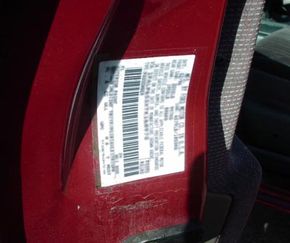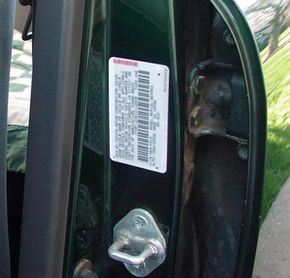Vehicle Identification Numbers (VINs) are unique identification sequences on every car manufactured in the United States and many other countries. These numbers are sort of like a fingerprint for a car. They help to keep track of problems, ownership changes, and deter theft. In this article, we'll find out where to find your car's VIN, what the numbers mean and how you can use VINs to help prevent theft or learn about the history of a used car.
A VIN is a 17-character sequence containing both numbers and letters. It is affixed to every car, truck or trailer made in the United States after 1981. No two cars built within 30 years of each other can have the same VIN. The Motor Vehicle Records database tracks information on a VIN, such as when the car was inspected, when it changed ownership and if it was involved in a serious crash, rollover or flood.
Advertisement
In 1987, the Department of Transportation's Motor Vehicle Theft Prevention Standard required manufacturers to also put the VIN on the major parts (like engines, hoods and fenders) of certain vehicles if the car is considered "high theft" [ref].
On most cars, you can find the VIN on the dashboard on the driver's side, and it's visible through the windshield from outside the car. It is usually on a sticker or plate on the inside of the driver's side door or on the frame sill where the door closes. The VIN is sometimes printed inside the glove compartment, and it's usually on the car's title and/or on insurance documents.
The United States Department of Transportation created a consistent, unified VIN system in 1981. Specifically, it included the VIN system in the Code of Federal Regulations, Title 49, Chapter V, Part 565 [ref]. Prior to 1981, auto manufacturers used their own numbering system to stamp cars with unique IDs. The VIN system conforms to a standard developed by the International Organization for Standardization in 1977: ISO 3779. Manufacturers use all letters and numbers, with the exception of the letters I, O and Q.
Each character in a VIN has a specific meaning, and the VIN is broken up into sections. The first section identifies the manufacturer of the vehicle, and uses the first three digits:
- The first digit identifies the nation of origin. If the car was assembled from parts produced in different countries, this digit reflects the nation where the car was assembled. Some larger nations are split into regions. For example, cars built in Japan are assigned a J in the first digit. But cars made in the U.S. can have a 1, 4 or 5, depending on the region of its assembly.
- The second digit identifies the manufacturer of the vehicle. In the United States, the Society for Automotive Engineers issues manufacturer codes.
- The third digit identifies a division within the manufacturer or a general vehicle type. For example, the code for an American-made Ford is 1F, and depending on the type of vehicle, it may be a 1FA, 1FB and so on. A U.S. General Motors vehicle is a 1G. Chevrolet is a division of GM, so the first three digits for a Chevrolet are 1GC.
The next five digits, four through eight, describe the vehicle. The specific use of these digits differs from one manufacturer to another. Here is an example that includes common code elements:
- The fourth digit might contain a code that represents the vehicle's weight, horsepower or both.
- The fifth digit often identifies the platform of the vehicle, such as van, pickup truck, trailer, sedan, et cetera.
- The sixth digit can be a special code used by the manufacturer, or it might identify the specific model of the vehicle, such as Corvette, Durango or Mustang.
- The seventh digit can be used to identify body type, such as four-door, two-door, hatchback or convertible.
- The eighth digit is used for information about the engine, such as number of cylinders and engine displacement.
Digits four through eight might also be coded for information on the transmission used, the grade of the car (i.e., Accord LX, DX, Si), or other features such as safety belts and air bags.
The next three digits are consistent among all manufacturers:
- The ninth digit is always a check digit. The other digits in the VIN go through a series of calculations to obtain the correct check digit. This allows computers to tell immediately if there is an error in the VIN, which often happens when someone transcribes a VIN or enters it into a computer.
- The model year digit is the tenth digit. Each year has a code character. From the 1980s until 2000, each year had a letter code, with 2000 assigned Y. 2001 was given code 1, 2002 is code 2, and so forth.
- The eleventh digit is the plant code, representing the factory where the car was assembled.
The last six digits, 12 through 17, are production sequence numbers, although small manufacturers that make fewer than 500 cars per year use the 12th, 13th and 14th digits as additional manufacturer identification codes. Production sequence numbers identify the vehicle itself, sort of like a serial number.
Since each manufacturer has a different code, and each car produced by the same factory has its own production sequence number, every car produced in a given year has a unique VIN.
The European Union has a similar regulation for VINs, but it is less stringent than the North American rule. European VINs are not required to include year, factory or vehicle attribute data. However, the two systems are compatible. While most countries have some form of VIN system that is compatible with the North American system, cars that are imported must have their VIN number entered into the MVR database along with enough information to explain what the codes are if the original VIN system differs from the ISO 3779 standard.
Advertisement

